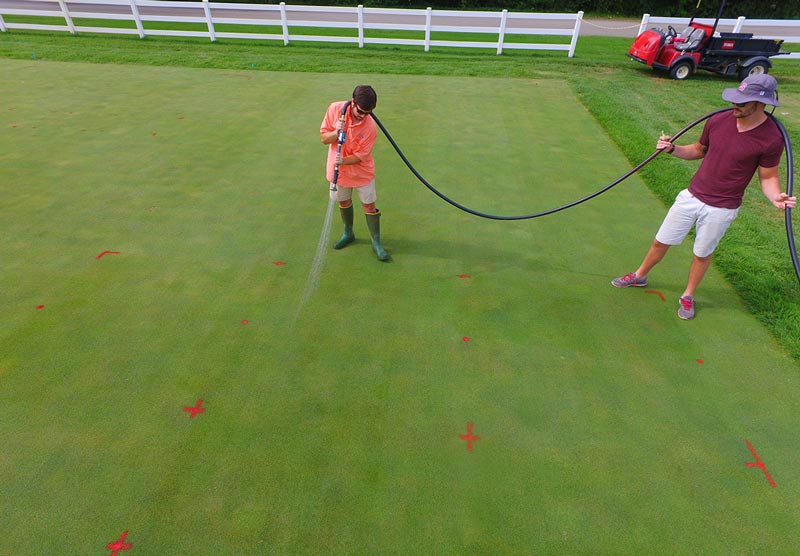
Photo by Daniel Freund
Field research was initiated to quantify the effect of post-application irrigation timing and volume on the distribution of Segway (cyazofamid, PBI-Gordon) in soil and on Pythium root rot control (in situ).
The research site was a Penn A-1/Penn A-4 creeping bentgrass green built to USGA recommendations and located at Lake Wheeler Turfgrass Field Laboratory in Raleigh, N.C. Segway was spray-applied at the maximum single application rate (1 pound a.i./acre) with equipment calibrated to deliver the lowest labeled carrier volume (87 gallons/acre). Following application, plots received either 0.12 or 0.24 inch irrigation immediately or six hours after treatment. Irrigation ceased for three days after application.
To quantify cyazofamid residue fate, plant and soil samples were collected 0 to 10 days after treatment. At 0, 1, 2, 3, 5, 7 and 10 days after treatment, turfgrass clippings were collected via walk-behind reel mower to quantify residue loss via clipping collection. At 0, 1, 5 and 7 days after treatment, cup cutter samples were taken and divided into four segments: remaining aboveground vegetation, and soil depths of 0 to 1 inch, 1 to 2 inches, and 2 to 3 inches.
Irrigating immediately after Segway application resulted in a fivefold increase in cyazofamid residue (32.4% to 36% of the amount applied) in the 0-to-1-inch soil depth compared with withholding irrigation until six hours after treatment (5.3% to 5.5%) at 0- and 1-day-after-treatment sample collection timings.
Data generated as a result of this research will inform turfgrass best management practices intended to enhance fungicide delivery to the target site (root zone) and provide information pertaining to dissipation kinetics of cyazofamid from golf course putting greens.
— Daniel Freund, Travis Gannon, Ph.D., and James Kerns, Ph.D., North Carolina State University, Raleigh, N.C.
Editor’s note: An earlier version of this summary was published in the 2019 ASA-CSSA-SSSA Meeting Abstracts, ASA-CSSA-SSSA, Madison, Wis.
Teresa Carson is GCM’s science editor.